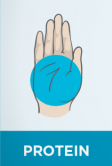How Much Protein Do You Need to Lose Weight?

If you eat too little protein -- which can happen if you cut down your calories too low -- you run the risk of losing muscle mass. And your body will have trouble repairing damage, building more muscle and bone, creating enzymes and hormones and fighting infections.
The problem is that your body needs certain essential amino acids it can only get from eating protein. Your body can’t store these essential amino acids and it can’t create them on its own.
And while a higher protein diet can help fight high blood pressure, diabetes, and osteoporosis, you’ll end up storing any extra protein as fat. No bueno.
That’s why eating a 16oz steak in one go doesn’t really do anything healthy for you. You can’t store the extra amino acids -- and all that extra protein will just be stored as fat. What a waste of good protein! You’d be better off eating that steak in 3 to 4 oz portions.
See: Do You Eat This High Protein Foods?
What’s the Minimum Amount of Protein You Need?
The amount of protein you need daily depends on a variety of factors, including your activity level, your age and whether you’re injured or not.- Athletes need more protein for their energy and muscle mass, especially if they’re weight training.
- Seniors need more to help ward off muscle and bone loss that's common in old age.
- And injured people need more for recovery and healing.
My protein needs calculator will calculate the minimum and maximum amount of daily protein you should be eating. It will calculate a range for healthy, sedentary individuals and a range for endurance athletes and strength athletes.
Protein Needs Calculator
The calculator is based off of these minimum and maximum protein formulas.
Minimum Recommendation
According to the National Institutes of Health (NIH), the minimum recommendation for protein per day is 46g of protein for women, and 56g of protein for men.You can also use this formula to calculate your minimum protein needs:
Minimum Protein Needs Formula:
0.8 g X kilogram of body weight = grams of protein per day.
Example:
0.8 X 68kg = 54 grams of protein per day.
You multiply 0.8 times your weight in kilograms.
If you’re using Imperial measures, you would calculate 0.36 grams per POUND of body weight.
Example:
0.36 X 150lbs = 54 grams of protein per day.
So, a 68 kg (150 lb) healthy non-athlete adult would need at least 54 grams of protein per day.
But minimum doesn’t mean optimal. Your protein needs might be greater to keep your body healthy and functioning normally.
To find your maximum protein needs, use this formula.
Maximum Protein Needs Formula
1.3 g X kilogram of body weight = grams of protein per day.
Example:
1.3 X 68kg = 88 grams of protein per day.
You multiply 1.3 times your weight in kilograms.
If you’re using Imperial measures, you would calculate 0.60 grams per POUND of body weight.
Example:
0.60 X 150lbs = 90 grams of protein per day.
How much protein is too much?
As with fat and carbohydrates, eating too much protein can cause weight gain. Extra protein can be converted into sugar or fat in the body. The interesting thing about protein is that it isn’t as easily or quickly converted as carbohydrates or fat; this is because of its thermic effect.The thermic effect is the amount of energy required to digest, absorb, transport and store a nutrient.
To digest protein, your body needs to spend energy -- that is, burn calories. More calories than when metabolizing fats or carbohydrates. More calories than when metabolizing fats or carbohydrates.
If you’re concerned that high protein intake harms healthy kidneys, don’t be. If your kidneys are healthy, they are more than capable of filtering out excess amino acids from the blood. The problem only occurs in people who already have kidney issues.
Which Foods are High in Protein?
You get protein from sources such as beef, poultry, fish — basically, any type of meat — and from other sources such as eggs, nuts and seeds, and tofu. And while vegetables aren’t high in protein, you can still get protein from vegetables.
Fun fact: if you ate 2000 calories worth of broccoli (about 10 bunches), you would get over 175g of protein. Check it out here: Protein in Broccoli
Not something I would recommend, of course! Who’d want to eat that much broccoli!
Here are some example of foods with their protein content, just to give you an idea.
- A 3.5 oz chicken breast has 31 g protein.
- A 3.5 oz can of salmon has 20 g protein.
- ½ cup cooked beans contain 6-9 g protein.
- A large egg contains 6 g protein.
- ¼ cup nuts contains 4-7 g protein.
- 1 medium baked potato contains 3 g protein.
- 1 scoop of protein powder has approximately 26g protein (check your label because it can vary).
Use Hand-Size Portions to Determine a Serving of Protein
Looking up grams of protein for everything you eat can get real old, real fast. One way to make sure you’re getting enough protein in the day to lose weight is to use hand-size portions. It’s a strategy my weight loss clients use to make sure they’re meeting their daily protein needs.See: Online Nutrition Coaching with Coach Suzanne
When it comes to protein, you use the palm of your hand to determine a serving of protein.
Look at the palm of your hand right now. See the width, length and height of your palm? That’s about a serving of protein. Use your palm as a “visual” to help you understand what a portion of protein is.
When it comes to how much protein you should eat in a day to lose weight, women should aim to eat 4 “palms” of protein per day, while men should aim for 6 to 8 palms of protein per day.
Each palm is about 22g to 24g of protein -- but again, it all depends on the size of your palm. (What's great about hand-size portions is that your hand is the right "size" for your body.)
This should give you an optimized portion of protein: enough to help keep you healthy and full, while not going overboard with protein which can cause weight gain.
You can learn more about hand-size portions here, and download my hand-size portion guide, too: Hand-Size Portions for Weight Loss
As you cut calories to lose weight, take a look at the meals and snacks you eat throughout the day. By adding protein to each meal and/or snack, you’ll be eating an optimal amount of protein to keep you healthy and keep muscle mass as you lose weight.
If you're looking to lose weight in a healthy way, I can help you figure out what's right for you. No diets. No rules. Just healthy eating by getting off the diet roller coaster.
References
https://www.ncbi.nlm.nih.gov/books/NBK56068/table/summarytables.t4/?report=objectonly
http://www.precisionnutrition.com/all-about-protein
http://www.health.harvard.edu/healthy-eating/do-you-eat-enough-protein
https://authoritynutrition.com/how-much-protein-per-day/
https://www.ideafit.com/fitness-library/protein-how-much-is-too-much
